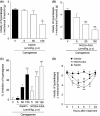NOSH-aspirin (NBS-1120), a dual nitric oxide and hydrogen sulfide-releasing hybrid, reduces inflammatory pain
- PMID: 26236481
- PMCID: PMC4492749
- DOI: 10.1002/prp2.133
NOSH-aspirin (NBS-1120), a dual nitric oxide and hydrogen sulfide-releasing hybrid, reduces inflammatory pain
Abstract
The development of nitric oxide (NO)- and hydrogen sulfide (H2S)-releasing nonsteroidal anti-inflammatory drugs (NSAIDs) has generated more potent anti-inflammatory drugs with increased safety profiles. A new hybrid molecule incorporating both NO and H2S donors into aspirin (NOSH-aspirin) was recently developed. In the present study, the antinociceptive activity of this novel molecule was compared with aspirin in different models of inflammatory pain. It was found that NOSH-aspirin inhibits acetic acid-induced writhing response and carrageenan (Cg)-induced inflammatory hyperalgesia in a dose-dependent (5-150 μmol/kg, v.o.) manner, which was superior to the effect of the same doses of aspirin. NOSH-aspirin's antinociceptive effect was also greater and longer compared to aspirin upon complete Freund's adjuvant (CFA)-induced inflammatory hyperalgesia. Mechanistically, NOSH-aspirin, but not aspirin, was able to reduce the production/release of interleukin-1 beta (IL-1β) during Cg-induced paw inflammation. Furthermore, NOSH-aspirin, but not aspirin, reduced prostaglandin E2-induced hyperalgesia, which was prevented by treatment with a ATP-sensitive potassium channel (KATP) blocker (glibenclamide; glib.). Noteworthy, the antinociceptive effect of NOSH-aspirin was not associated with motor impairment. The present results indicate that NOSH-aspirin seems to present greater potency than aspirin to reduce inflammatory pain in several models. The enhanced effects of NOSH-aspirin seems to be due to its ability to reduce the production of pronociceptive cytokines such as IL-1 β and directly block hyperalgesia caused by a directly acting hyperalgesic mediator in a mechanism dependent on modulation of KATP channels. In conclusion, we would like to suggest that NOSH-aspirin represents a prototype of a new class of analgesic drugs with more potent effects than the traditional NSAID, aspirin.
Keywords: Aspirin and NOSH-aspirin; hyperalgesia; inflammatory pain; prostaglandins.
Figures






Similar articles
-
Anticancer and Anti-Inflammatory Mechanisms of NOSH-Aspirin and Its Biological Effects.Comput Math Methods Med. 2022 Aug 17;2022:4463294. doi: 10.1155/2022/4463294. eCollection 2022. Comput Math Methods Med. 2022. Retraction in: Comput Math Methods Med. 2023 Jul 12;2023:9861539. doi: 10.1155/2023/9861539. PMID: 36035295 Free PMC article. Retracted. Review.
-
NOSH-aspirin (NBS-1120), a novel nitric oxide- and hydrogen sulfide-releasing hybrid is a potent inhibitor of colon cancer cell growth in vitro and in a xenograft mouse model.Biochem Biophys Res Commun. 2012 Mar 16;419(3):523-8. doi: 10.1016/j.bbrc.2012.02.051. Epub 2012 Feb 16. Biochem Biophys Res Commun. 2012. PMID: 22366248
-
NOSH-sulindac (AVT-18A) is a novel nitric oxide- and hydrogen sulfide-releasing hybrid that is gastrointestinal safe and has potent anti-inflammatory, analgesic, antipyretic, anti-platelet, and anti-cancer properties.Redox Biol. 2015 Dec;6:287-296. doi: 10.1016/j.redox.2015.08.012. Epub 2015 Aug 14. Redox Biol. 2015. PMID: 26298203 Free PMC article.
-
NOSH-aspirin (NBS-1120), a novel nitric oxide- and hydrogen sulfide-releasing hybrid has enhanced chemo-preventive properties compared to aspirin, is gastrointestinal safe with all the classic therapeutic indications.Biochem Pharmacol. 2015 Dec 15;98(4):564-72. doi: 10.1016/j.bcp.2015.09.014. Epub 2015 Sep 21. Biochem Pharmacol. 2015. PMID: 26394025 Free PMC article.
-
NSAIDs, coxibs, CINOD and H2S-releasing NSAIDs: what lies beyond the horizon.Dig Liver Dis. 2007 Dec;39(12):1043-51. doi: 10.1016/j.dld.2007.09.001. Epub 2007 Nov 7. Dig Liver Dis. 2007. PMID: 17997373 Review.
Cited by
-
The dichotomous role of H2S in cancer cell biology? Déjà vu all over again.Biochem Pharmacol. 2018 Mar;149:205-223. doi: 10.1016/j.bcp.2018.01.042. Epub 2018 Feb 14. Biochem Pharmacol. 2018. PMID: 29397935 Free PMC article. Review.
-
Anticancer and Anti-Inflammatory Mechanisms of NOSH-Aspirin and Its Biological Effects.Comput Math Methods Med. 2022 Aug 17;2022:4463294. doi: 10.1155/2022/4463294. eCollection 2022. Comput Math Methods Med. 2022. Retraction in: Comput Math Methods Med. 2023 Jul 12;2023:9861539. doi: 10.1155/2023/9861539. PMID: 36035295 Free PMC article. Retracted. Review.
-
Gasotransmitters in the tumor microenvironment: Impacts on cancer chemotherapy (Review).Mol Med Rep. 2022 Jul;26(1):233. doi: 10.3892/mmr.2022.12749. Epub 2022 May 26. Mol Med Rep. 2022. PMID: 35616143 Free PMC article. Review.
-
The Triple Crown: NO, CO, and H2S in cancer cell biology.Pharmacol Ther. 2023 Sep;249:108502. doi: 10.1016/j.pharmthera.2023.108502. Epub 2023 Jul 28. Pharmacol Ther. 2023. PMID: 37517510 Free PMC article. Review.
-
Inhibition of hepatic gluconeogenesis in type 2 diabetes by metformin: complementary role of nitric oxide.Med Gas Res. 2025 Dec 1;15(4):507-519. doi: 10.4103/mgr.MEDGASRES-D-24-00100. Epub 2025 Apr 29. Med Gas Res. 2025. PMID: 40300886 Free PMC article. Review.
References
-
- Alves DP, Tatsuo MA, Leite R, Duarte ID. Diclofenac-induced peripheral antinociception is associated with ATP-sensitive K+ channels activation. Life Sci. 2004;74:2577–2591. - PubMed
-
- American Gastroenterological Association. Study Shows Long-term Use Of NSAIDs Causes Severe Intestinal Damage. ScienceDaily. 2005 , January 16). Available at http://www.sciencedaily.com/releases/2005/01/050111123706.htm (accessed September 01, 2014)
-
- Bradley PP, Priebat DA, Christensen RD, Rothstein G. Measurement of cutaneous inflammation: estimation of neutrophil content with an enzyme marker. J Invest Dermatol. 1982;78:206–209. - PubMed
LinkOut - more resources
Full Text Sources
Other Literature Sources
Research Materials
Miscellaneous

